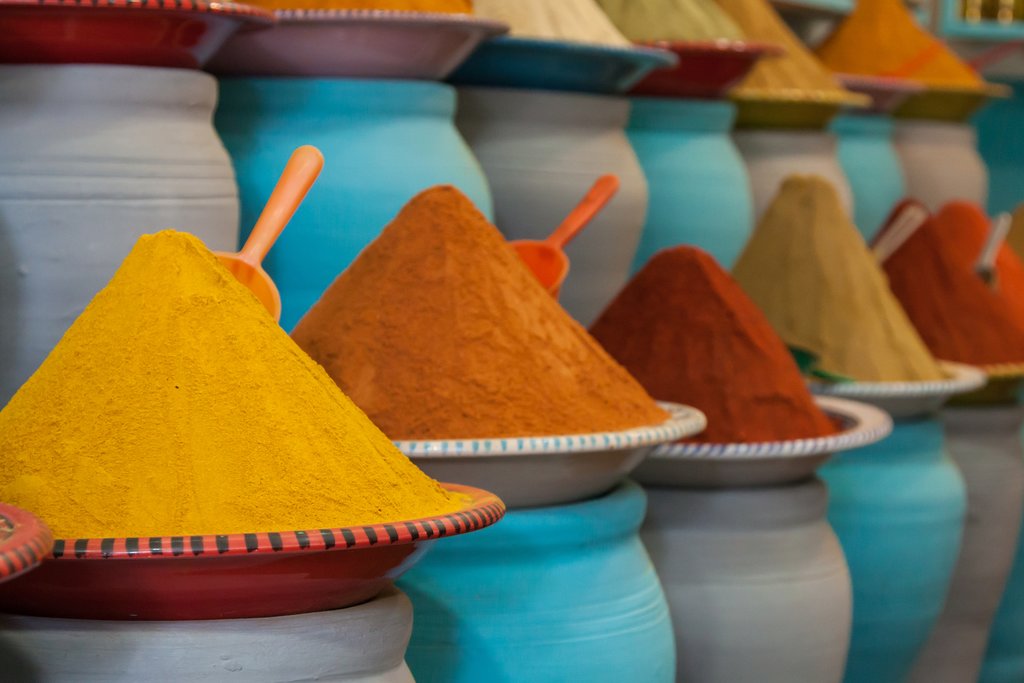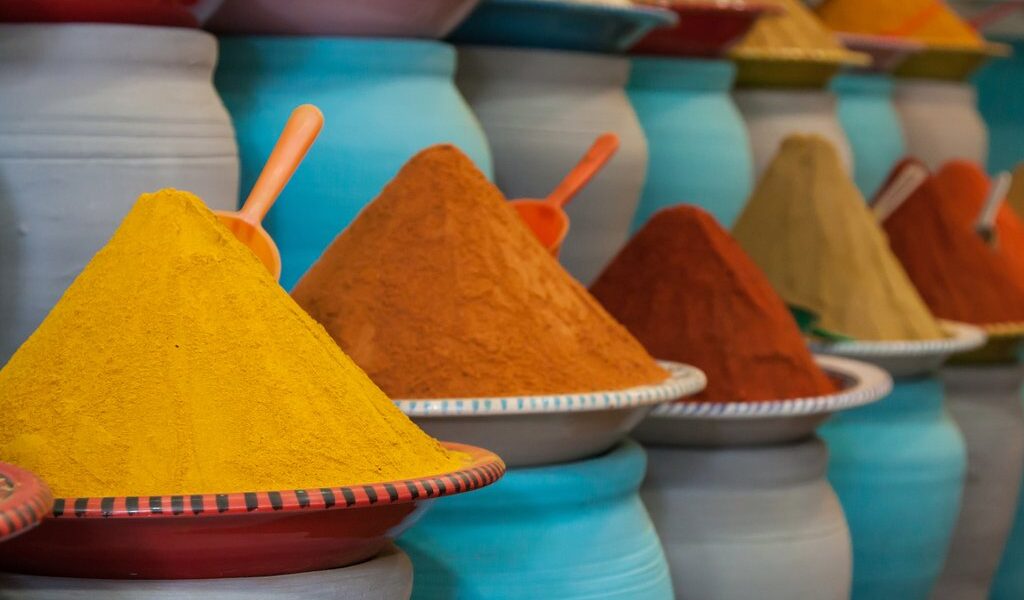
Butter-soft lamb, spicy, aromatic tagines, syrupy sweets stuffed with almond paste and drizzled with orange flower water: Marrakech cuisine is at once highly nuanced and deeply satisfying. Read on to find out how to dig in to the most authentic flavours and where.
## A Culinary Journey Through Marrakech: Savoring the Flavors of Morocco
Marrakech, a city of vibrant colors, intoxicating aromas, and a rich cultural heritage, offers an unforgettable experience for all the senses. And what better way to immerse yourself in the heart of Marrakech than through its captivating cuisine? While no single dish can truly encapsulate the essence of Marrakech, a few culinary masterpieces stand out, each telling a story of tradition, artistry, and the unique flavors of Morocco. Let’s embark on a gastronomic adventure to discover some of the must-try dishes in Marrakech, along with the best places to savor these culinary delights.
## Méchoui: A Feast Fit for Royalty
One dish that readily appears on special occasions, including a family *diffa* (feast), is méchoui. Deeply rooted in Moroccan culture, this is more than just a meal; it’s a celebration. Méchoui is a hearty dish featuring lamb or mutton, cooked to such melting tenderness that the meat effortlessly falls off the bone with the gentlest touch of a finger or the lightest pressure from a fork. The secret to this exquisite tenderness, as locals will readily admit, lies in the meticulous preparation.
It’s not simply a cut of meat that makes méchoui; it’s a transformation. A whole lamb is carefully selected, and the entrails are removed with precision. The meat is then generously seasoned with a symphony of spices, including the warm glow of saffron, the earthy depth of cumin, and the complex aromatic blend of ras-el-hanout. Once the meat has been thoroughly marinated, absorbing the flavors of the spices, it is carefully placed on a spit. This spit is then positioned beside glowing embers within an underground clay pit, a traditional method that ensures even and slow cooking. The lamb roasts slowly for several hours, patiently transforming into a masterpiece of culinary art. The result is meat that is unbelievably soft and tender, with a beautifully crisp and flavorful skin that crackles with each bite.
For a truly authentic experience, venture into the heart of Marrakech and head to ‘**Méchoui Alley**’, a traditional enclave sidling up to the bustling souks in the northeast corner of Jemma el-Fna. Here, you’ll find simple, hole-in-the-wall establishments that serve up the real deal. Plates are piled high with succulent méchoui, accompanied by warm, freshly baked flatbread to mop up the flavorful juices. Don’t hesitate to ask nicely; they might even grant you a peek at the underground oven where the magic happens. The aroma alone is enough to make your mouth water!
If you’re seeking a more refined and upscale dining experience, consider booking a table at **Le Trou au Mur**. This establishment roasts its méchoui according to a carefully guarded family secret, passed down through generations. The dish is served in a classy, Berber-chic riad setting, offering a luxurious ambiance to complement the exquisite flavors. For a truly memorable experience, opt for a table on the rooftop terrace, where you can enjoy your méchoui while taking in the breathtaking views of Marrakech.
## B’stilla: A Sweet and Savory Symphony
If you’ve never had the pleasure of trying Moroccan pigeon pie, now is undoubtedly the time. B’stilla is not just a dish; it is a delicacy, a culinary masterpiece fit for a sultan. This exquisite pie features light, paper-thin, filo-like pastry layers that encase a succulent filling. Traditionally, the filling consists of squab pigeon, but chicken is sometimes used as a substitute. The savory meat is combined with almonds, parsley, and a medley of aromatic spices, including saffron, ginger, and cinnamon.
The unique aspect of B’stilla lies in its harmonious blend of sweet and savory flavors. The flaky crust is delicately dusted with powdered sugar, creating a sweet counterpoint to the rich and savory filling. The result is a culinary experience that is both surprising and delightful, a testament to the artistry of Moroccan cuisine.
While most Moroccan restaurants offer B’stilla, some establishments stand out for their exceptional renditions of this classic dish. **Libzar**, an intimate and contemporary restaurant in Gueliz, is a great choice. Chef Assia’s home cooking is renowned, and her B’stilla is prepared with the freshest ingredients and a genuine passion for flavor. Alternatively, for an evening of old-fashioned opulence and entertainment, venture to the candlelit **Red House**, where the B’stilla is made with homemade spices. The Red House also offers a unique seafood version of B’stilla, catering to diverse palates. While enjoying your B’stilla, you can immerse yourself in the vibrant atmosphere, complete with captivating belly dancing performances.
## Harira: A Soup of the Soul
Harira is more than just a soup; it is a cultural icon, deeply embedded in the heart and soul of Morocco. This thick, comforting, and well-spiced soup is traditionally served to break the sunset-to-dusk Ramadan fast, a time of reflection and spiritual devotion. Often appearing on Marrakech menus as an appetizer or a light snack, harira is substantial enough to be a complete meal in itself.
The name harira derives from the Arabic word *harir*, meaning silk, a reference to the soup’s luxuriously smooth and silky texture. While there is no single, definitive recipe for harira, many agree on the essential ingredients that contribute to its distinctive flavor. Lentils and chickpeas form the base of the soup, providing a hearty and nutritious foundation. Tomato, onion, celery, and garlic add depth and complexity to the flavor profile. The aromatic spices, including cumin, turmeric, saffron, and cinnamon, create a warm and inviting fragrance. Fresh cilantro and parsley provide a burst of herbal freshness. Meat, such as lamb, is an optional addition, adding richness and protein to the soup. All of these ingredients are simmered slowly together, allowing the flavors to meld and deepen, creating a robust and harmonious taste that intensifies over time.
To experience harira in its most authentic form, head to the bustling food stalls in **Jemma el-Fna**, where chefs ladle out steaming bowls of the soup to hungry patrons. Alternatively, venture to the delightfully old-school **Al Fassia** in the Gueliz neighborhood, where this classic soup is prepared with a pinch of love by an all-female team of chefs.
## Tanjia: A Marrakech Specialty
Tanjia is a true Marrakech specialty, a culinary gem that sets the city apart. Unlike tagine, which is found throughout Morocco, tanjia is distinctly Marrakchi. The term tanjia refers to both the flavorful meaty stew and the terracotta urn in which it is traditionally cooked.
The preparation of tanjia is a labor of love, a testament to the slow-cooking traditions of Moroccan cuisine. Traditionally, the tanjia is slow-cooked for many hours in the ashes of the *farnatchi*, the searingly hot communal oven that is also used to bake bread and heat the hammam. The sealed terracotta pot is filled with tender beef shank, preserved lemon for a citrusy zest, garlic, cilantro, parsley, cumin, saffron, a touch of olive oil, and a smidgen of *smen* (salted fermented butter) for added richness.
For an authentic tanjia experience, venture to the simple tanjia stalls just off **Souk Semmarine**, where you’ll find some of the city’s best offerings. If you’re seeking a more refined and upscale experience, consider **La Sultana**, with its romantic, lantern-lit arcades framing a serene pool, or the palatial dining room of **La Maison Arabe**.
## Moroccan Sweetmeats: A Miniature World of Delights
Moroccan sweetmeats are a miniature culinary world unto themselves, offering a delightful array of flavors and textures. These bite-sized treats are utterly irresistible, oozing with honey, packed with nuts, wrapped in wafer-thin pastry, and exotically perfumed with cinnamon, orange flower water, and rose water.
While you’ll find many variations on baklava, Moroccan sweetmeats offer a unique selection of local specialties. *Cornes de gazelle* (literally ‘gazelle’s horns’) are crescent-shaped pastries made with smooth, paper-thin dough, filled with almonds and sprinkled with orange blossom water. *Fekkass*, similar to biscotti, are twice-baked almond-and-raisin cookies that offer a satisfying crunch. *Halwa dyal makina* are piped cookies dipped in chocolate, providing a delightful combination of flavors. Fragrant *ghoriba* cookies, made with almond or coconut, range in texture from chewy macaroons to crumbly shortbread.
Marrakech locals have a serious sweet tooth, and you’ll often find a sweetmeat perched beside your pot of mint tea. In the souks, seek out the tiny **Patisserie Belkabir** for a take-away box filled with these delectable treats. Alternatively, head up to the cool, sun-shaded rooftop of **Terrasse des épices**, which boasts a great in-house bakery. Northwest of the medina, in the French colonial-era Gueliz, you’ll find Marrakech’s best patisseries lining the wide avenues. **Amandine**, **Jaouda**, and **Gato** should certainly be on your radar for a taste of authentic Moroccan pastries.
## Mint Tea: The Elixir of Moroccan Hospitality
No culinary journey through Marrakech is complete without experiencing the ritual of mint tea, known locally as *thé à la menthe* and wittily nicknamed ‘Berber whiskey’. This cornerstone of Moroccan hospitality is sipped at all hours and on all occasions. You’ll often be offered a glass to sweeten you up for haggling in the souks or as a gesture of welcome upon arrival at a riad.
Mint tea is a simple yet elegant concoction of spearmint, gunpowder green tea, and sugar. The tea is served ceremonially, poured from a gleaming silver teapot from a great height to aerate the tea, creating a frothy top and releasing the aroma, into tinkling glasses. While slurping your tea might be frowned upon in other settings, here it’s encouraged as it enhances the sensory experience.
For a memorable mint tea experience, visit **Le Grand Balcon du Café Glacier**, which offers a ringside view of Jemma el-Fna. Alternatively, enjoy a pot of mint tea on the street terrace of the French colonial **Le Grand Cafe de La Poste** in Gueliz.
## Tagine: A Moroccan Classic
A classic dish that needs little introduction, the tagine is a must-try on any visit to Marrakech. Tagine is named after the conical clay vessel in which it is cooked, and this slow-cooked stew is incredibly flavorful and satisfying. All versions of tagine include layered vegetables such as potato, carrot, green beans, zucchini, and onions, along with a blend of herbs and spices like parsley, turmeric, cumin, paprika, and cinnamon. Chicken tagines are often studded with preserved lemons and olives, adding a zesty brightness to the dish, while beef and lamb varieties may include dates and apricots, offering a touch of sweetness.
Tagines are featured on almost every menu in Marrakech, and you can even learn to prepare your own at most cookery classes. Some of the tastiest tagines are served at **Nomad**, with its roof terrace nestled in the heart of the souks, and at the glamorous, Arabian Nights-style **Le Comptoir Darna**, where you can enjoy your meal while being entertained by belly dancers.
B-1631

